What's inside
What's inside
 Key Ingredients
Key Ingredients

 Benefits
Benefits

 Concerns
Concerns

 Ingredients Side-by-side
Ingredients Side-by-side

Water
Skin ConditioningSodium Lauroyl Isethionate
CleansingSodium Methyl Lauroyl Taurate
CleansingCocamidopropyl Betaine
CleansingLauric Acid
CleansingSodium Hydroxypropyl Starch Phosphate
AbrasiveHydrogenated Soybean Oil
EmollientGlycine Soja Oil
EmollientSodium Chloride
MaskingGlycerin
HumectantStearic Acid
CleansingPalmitic Acid
EmollientHydrogenated Vegetable Glycerides
EmollientGlyceryl Stearate
EmollientHydroxystearic Acid
CleansingSodium Benzoate
MaskingGuar Hydroxypropyltrimonium Chloride
Skin ConditioningParfum
MaskingCitric Acid
BufferingCapryloyl Glycine
CleansingUndecylenoyl Glycine
CleansingSodium Gluconate
Skin ConditioningWater, Sodium Lauroyl Isethionate, Sodium Methyl Lauroyl Taurate, Cocamidopropyl Betaine, Lauric Acid, Sodium Hydroxypropyl Starch Phosphate, Hydrogenated Soybean Oil, Glycine Soja Oil, Sodium Chloride, Glycerin, Stearic Acid, Palmitic Acid, Hydrogenated Vegetable Glycerides, Glyceryl Stearate, Hydroxystearic Acid, Sodium Benzoate, Guar Hydroxypropyltrimonium Chloride, Parfum, Citric Acid, Capryloyl Glycine, Undecylenoyl Glycine, Sodium Gluconate
Water
Skin ConditioningSodium Lauryl Sulfate
CleansingCocamidopropyl Betaine
CleansingParfum
MaskingCoco-Glucoside
CleansingGlyceryl Oleate
EmollientGlyceryl Stearate
EmollientGlycol Distearate
EmollientAmmonium Chloride
BufferingCitric Acid
BufferingGlycerin
HumectantLauryl Lactate
EmollientMethyl Glucose Caprate/Caprylate/Oleate
EmollientPolyglyceryl-3 Laurate
EmulsifyingPropanediol
SolventCamellia Sinensis Leaf Extract
AntimicrobialCucumis Sativus Fruit Extract
EmollientFucus Vesiculosus Extract
EmollientEthylhexylglycerin
Skin ConditioningMethylchloroisothiazolinone
PreservativeMethylisothiazolinone
PreservativePhenoxyethanol
PreservativeWater, Sodium Lauryl Sulfate, Cocamidopropyl Betaine, Parfum, Coco-Glucoside, Glyceryl Oleate, Glyceryl Stearate, Glycol Distearate, Ammonium Chloride, Citric Acid, Glycerin, Lauryl Lactate, Methyl Glucose Caprate/Caprylate/Oleate, Polyglyceryl-3 Laurate, Propanediol, Camellia Sinensis Leaf Extract, Cucumis Sativus Fruit Extract, Fucus Vesiculosus Extract, Ethylhexylglycerin, Methylchloroisothiazolinone, Methylisothiazolinone, Phenoxyethanol
 Reviews
Reviews

Ingredients Explained
These ingredients are found in both products.
Ingredients higher up in an ingredient list are typically present in a larger amount.
Citric Acid is an alpha hydroxy acid (AHA) naturally found in citrus fruits like oranges, lemons, and limes.
Like other AHAs, citric acid can exfoliate skin by breaking down the bonds that hold dead skin cells together. This helps reveal smoother and brighter skin underneath.
However, this exfoliating effect only happens at high concentrations (20%) which can be hard to find in cosmetic products.
Due to this, citric acid is usually included in small amounts as a pH adjuster. This helps keep products slightly more acidic and compatible with skin's natural pH.
In skincare formulas, citric acid can:
While it can provide some skin benefits, research shows lactic acid and glycolic acid are generally more effective and less irritating exfoliants.
Most citric acid used in skincare today is made by fermenting sugars (usually from molasses). This synthetic version is identical to the natural citrus form but easier to stabilize and use in formulations.
Read more about some other popular AHA's here:
Learn more about Citric AcidCocamidopropyl Betaine is a fatty acid created by mixing similar compounds in coconut oil and dimethylaminopropylamine, a compound with two amino groups.
This ingredient is a surfactant and cleanser. It helps gather the dirt, pollutants, and other impurities in your skin to be washed away. It also helps thicken a product and make the texture more creamy.
Being created from coconut oil means Cocamidopropyl Betaine is hydrating for the skin.
While Cocamidopropyl Betaine was believed to be an allergen, a study from 2012 disproved this. It found two compounds in unpure Cocamidopropyl Betaine to be the irritants: aminoamide and 3-dimethylaminopropylamine. High-grade and pure Cocamidopropyl Betaine did not induce allergic reactions during this study.
Learn more about Cocamidopropyl BetaineGlycerin is already naturally found in your skin. It helps moisturize and protect your skin.
A study from 2016 found glycerin to be more effective as a humectant than AHAs and hyaluronic acid.
As a humectant, it helps the skin stay hydrated by pulling moisture to your skin. The low molecular weight of glycerin allows it to pull moisture into the deeper layers of your skin.
Hydrated skin improves your skin barrier; Your skin barrier helps protect against irritants and bacteria.
Glycerin has also been found to have antimicrobial and antiviral properties. Due to these properties, glycerin is often used in wound and burn treatments.
In cosmetics, glycerin is usually derived from plants such as soybean or palm. However, it can also be sourced from animals, such as tallow or animal fat.
This ingredient is organic, colorless, odorless, and non-toxic.
Glycerin is the name for this ingredient in American English. British English uses Glycerol/Glycerine.
Learn more about GlycerinGlyceryl Stearate is a mix of glycerin and stearic acid.
It is used to stabilize the mixing of water and oil ingredients. By preventing these ingredients from separating, it can help elongate shelf life. It can also help thicken the product's texture.
As an emollient, it helps soften skin and supports barrier-replenishing ingredients.
In cosmetics, Glyceryl Stearate is often made from vegetable oils or synthetically produced.
This ingredient may not be fungal-acne safe
Fun fact: The human body also creates Glyceryl Stearate naturally.
Learn more about Glyceryl StearateParfum is a catch-all term for an ingredient or more that is used to give a scent to products.
Also called "fragrance", this ingredient can be a blend of hundreds of chemicals or plant oils. This means every product with "fragrance" or "parfum" in the ingredients list is a different mixture.
For instance, Habanolide is a proprietary trade name for a specific aroma chemical. When used as a fragrance ingredient in cosmetics, most aroma chemicals fall under the broad labeling category of “FRAGRANCE” or “PARFUM” according to EU and US regulations.
The term 'parfum' or 'fragrance' is not regulated in many countries. In many cases, it is up to the brand to define this term.
For instance, many brands choose to label themselves as "fragrance-free" because they are not using synthetic fragrances. However, their products may still contain ingredients such as essential oils that are considered a fragrance by INCI standards.
One example is Calendula flower extract. Calendula is an essential oil that still imparts a scent or 'fragrance'.
Depending on the blend, the ingredients in the mixture can cause allergies and sensitivities on the skin. Some ingredients that are known EU allergens include linalool and citronellol.
Parfum can also be used to mask or cover an unpleasant scent.
The bottom line is: not all fragrances/parfum/ingredients are created equally. If you are worried about fragrances, we recommend taking a closer look at an ingredient. And of course, we always recommend speaking with a professional.
Learn more about ParfumWater. It's the most common cosmetic ingredient of all. You'll usually see it at the top of ingredient lists, meaning that it makes up the largest part of the product.
So why is it so popular? Water most often acts as a solvent - this means that it helps dissolve other ingredients into the formulation.
You'll also recognize water as that liquid we all need to stay alive. If you see this, drink a glass of water. Stay hydrated!
Learn more about Water